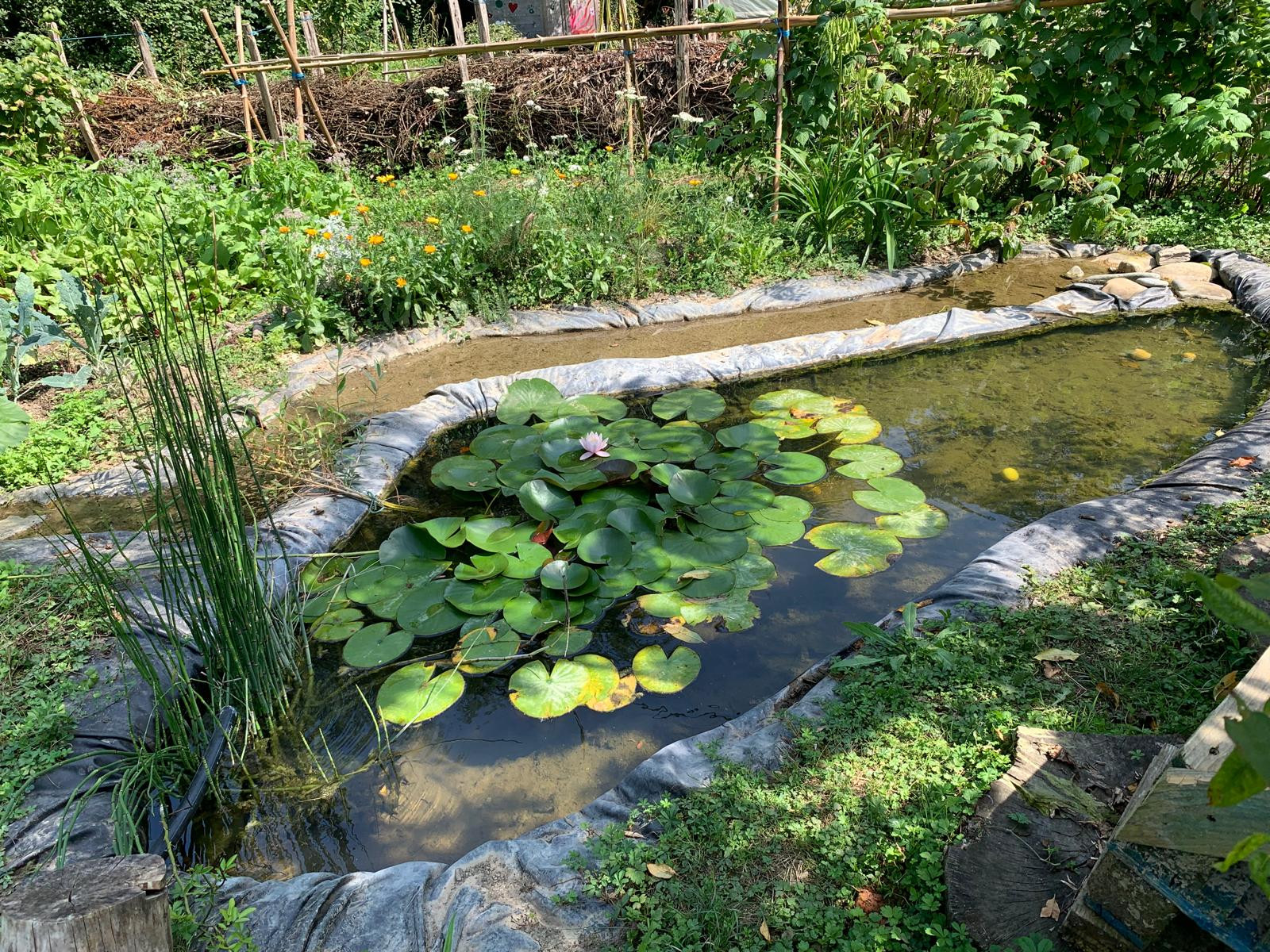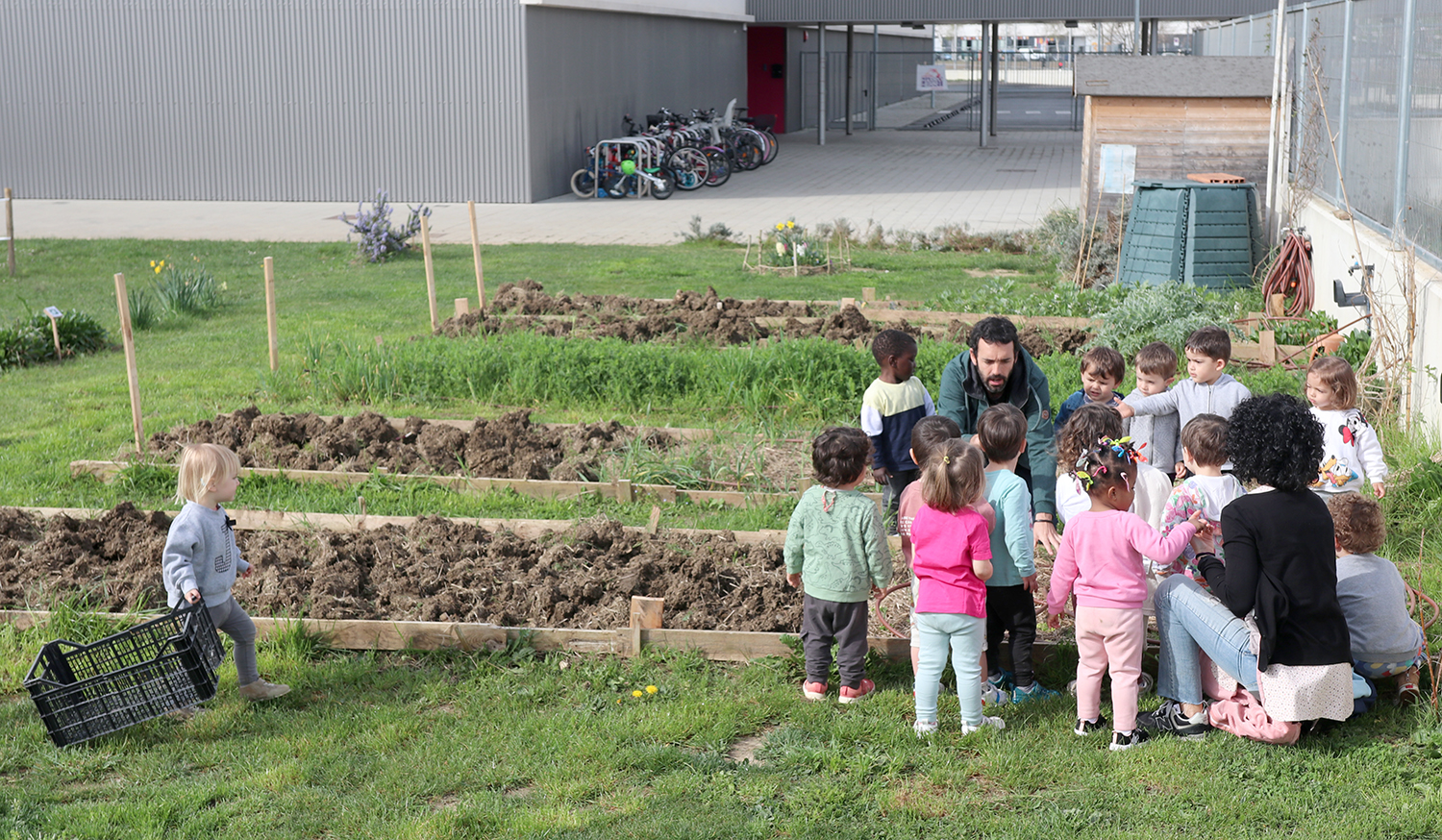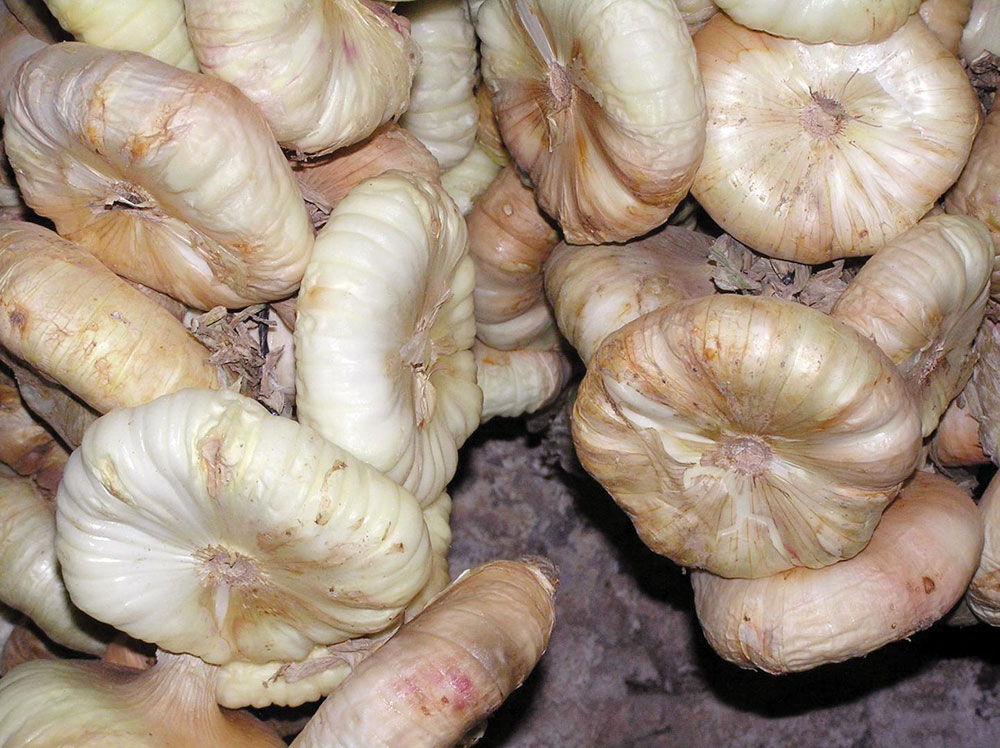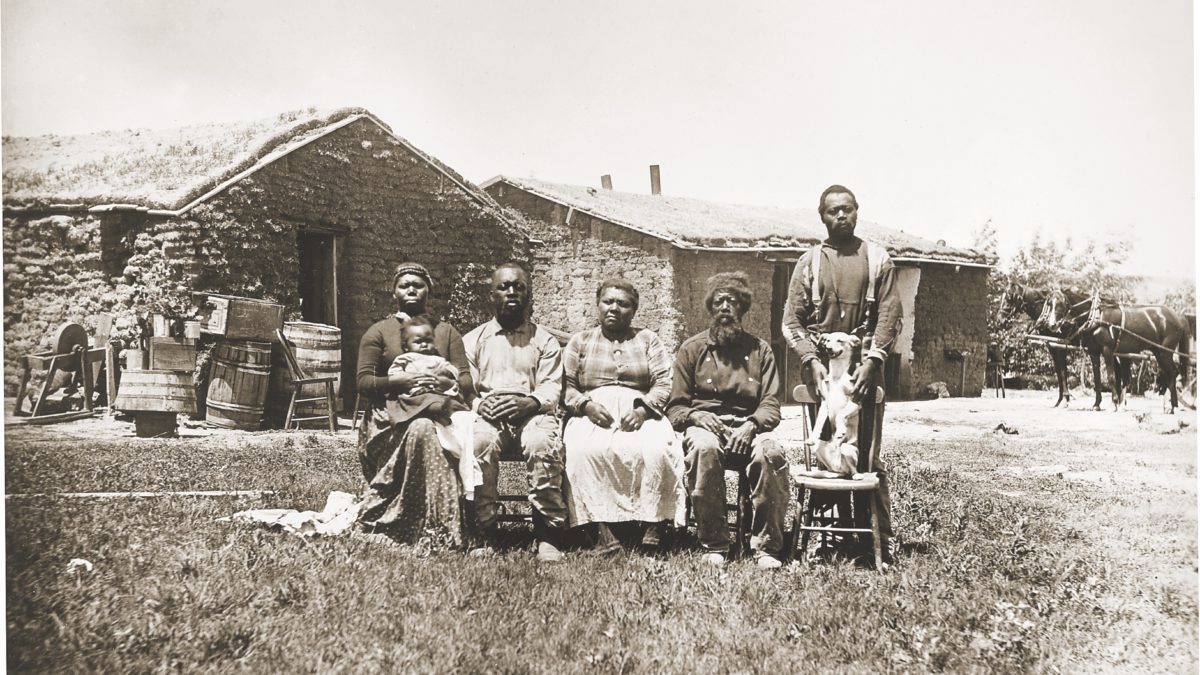"In the orchard, it's also interesting who runs out of control."
- To Zirimi now yes, now no, but there's a nice temperature and we've interviewed outside. We've climbed the chairs from the house portal to the top field table. Argi also wanted to be with us. Once it's finished it doesn't rain. The dog is still next to him. But something has changed in the way I look, sort and understand my environment. The plants of the road I've come are not the same ones that have turned me.
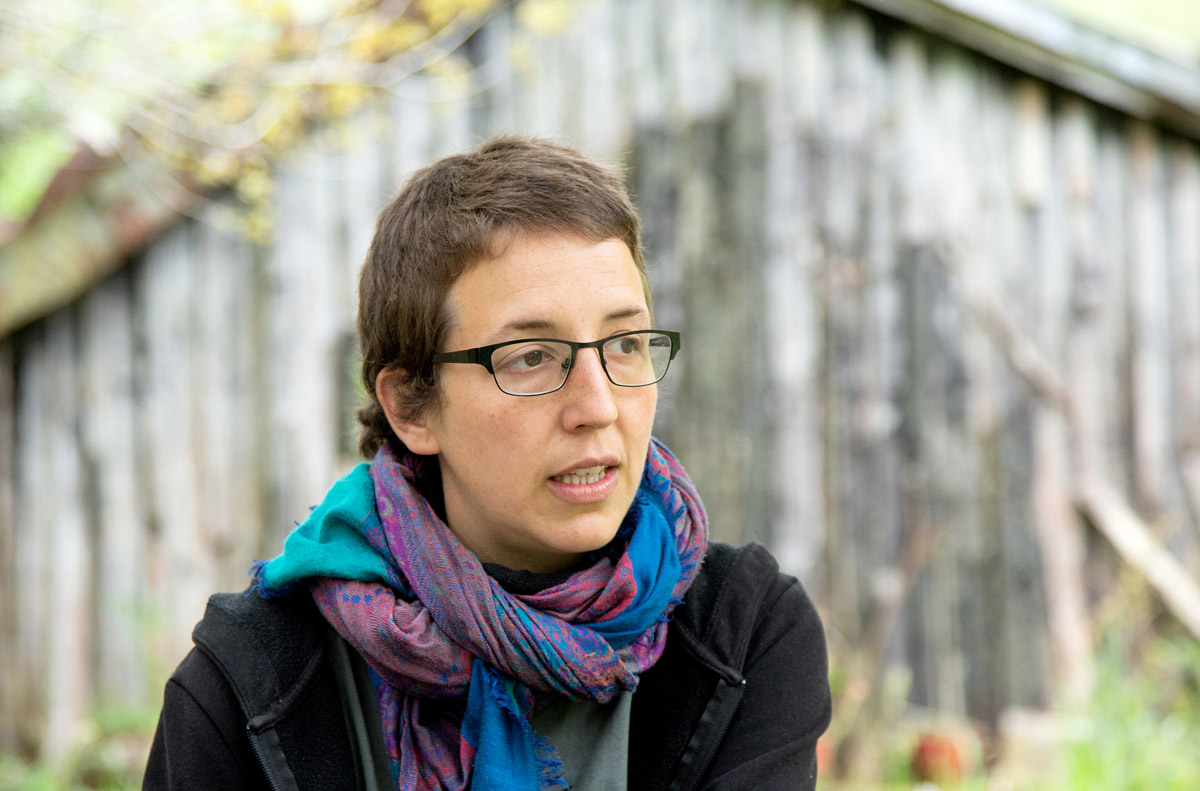
Herrialde Katalanetan hazia izanik, Urumea bailarara aldatu, eta bertan bota ditu erroak. Soziologian lizentziatu ondoren (2012) Ikasketa Feministetan masterra egin (2014) eta antropologiaren adarretik bukatu berri du tesia (2021). Bioaniztasunean eragiten duten prozesu sozialak eta kulturalak aztertu ditu, bi tomate barietateren kasu azterketatik abiatuz. Tomate haziek iraganeko tomateei eta etorkizunekoei buruz hitz egiteaz gain, gure kulturari buruz ere hitz egiten digutelako.
How do you remember your childhood?
I come from a Catholic Christian family. Very familiar, too. Together with our sisters and parents we lived in a 14-story block in Bellvitg, in a neighborhood of Hospitalet del Llobregat. Concrete was normal for me. But at the same time, the parents had a house with two other families in the area of Girona, in a town of four houses. In summer we were there the three families, sharing the same bathroom. And we went a lot to the mountain. I always remember the people around you. Concrete, mountain and people.
Once you grew up, you decided to study sociology. I started in Barcelona and ended up in Euskal
Herria… In adolescence I had many political concerns, but in my environment I did not find where to develop. I decided to study Sociology, and there I was feeding my criticity. I remember when we studied Marx I had enlightenment! But as soon as I started studying, that first summer I was working in a mountain shelter, 2,000 meters away for two months. When I came back from there, I couldn't continue where I left my life. Suddenly, Plaça Catalunya became terrible and rare to me, for example. Those underground subway and train crossings from there… What was until then normal ruined me. And I decided that I wanted to get out of the city, and by the way, also out of Catalonia. So I decided to come to Bilbao.
What relationship did he suspend when he came to Bilbao and what new connections did he build?
I interrupted many of the threads that joined that Martha until then. I started making big, small decisions in my life. Where to buy, what to buy… And I got really stuck in the Basque Country and in the militancy. In the fight against TAV, against fracking, in the Black Star Libertarian Athenaeum, in the vegan dining room… In the second year we thought that a friend and I wanted to occupy a house. From there I lived in several houses, occupying or giving in, in Galdakao first, in Orozko later… Where, us there. And on that home tour, I knew the relationship between orchard and self-management. From there emerged the project of settling in a house to develop a life in my bosom.
From there this house?
Indeed. I wanted in Bizkaia, but, look, I ended up in the Urumea valley. When I got the scholarship to do the PhD, I was at Arratia. The people in the area were looking forward to building a life in the countryside, but not quite as I wanted. I wanted a life that, along with self-management and gardening, would question the traditional family or partner structures. So I came to live in this valley with Ainara, known for the fight against VAT. It was a transition. Little by little, we got together four women, we started looking for a home and occupied this one. I've been in this valley for six years now, and in addition to domestic relationships, I'm building a network. In Errotz.

"With tomato Jack, you're sowing the same thing every year. Buy seed and sow seed. But it's the same seed. There's no development. It doesn't allow you to escape control."
How does one end up making an anthropological thesis about tomatoes?
I saw my life tied to the hamlet, and I also wanted to get closer to it through research, perhaps in a more idealized way than I am now. The starting point was in my personal project. I wanted to think about the farmhouse, about the work of the orchard. A friend of my thesis director, Olatz González Abrisketa, was doing research on GMOs, and we started talking about seeds. The theme motivated me a lot, so I decided not only to do the end of the master's work, but to do the thesis around the seeds. More than a very
general project, I would like to start from a crop. Take a specific case and analyze it for more general conclusions. At that time, the researcher and colleague Marc Badal told me that in Euskal Herria there is a half-serious mood and an enormous obsession with tomatoes, and that it was necessary to anthropologically explain why the tomato is so important here, if precisely here it is bad. So I started looking at the tomatoes and I met the case of the Larrosa variety of Aretxabaleta, on the one hand, and that of Tomatea Vasca by Jack Monsanto, on the other. And I thought I'd make a contrast between the two varieties.
Jack and Larrosa from Aretxabaleta. Would you introduce us each?
Larrosa is said to be an indigenous variety of Aretxabaleta. He's been here for 40 years. Their seeds can be harvested and replanted, so it gives autonomy to the grower. The Jack variety is hybrid. This means that in order to create these seeds you have to cross two different parenthood. To do this, first you have to have those parents and know how to cross, second, and it's not easy. In addition, only Monsanto knows what the parentheses are. Consequently, in order to obtain these seeds, the grower must purchase them each year. This tomato has been here for 30 years, and if we buy a tomato labeled Basque Tomato, it's probably this kind of tomato, because it's the one that sells the most.
In your research you've collected stories about the history and varieties of each variety.
Something like that. For example, Larrosa, from Aretxabaleta, has become a variety due to the many casualties that have happened. I knew I had come to the hands of someone I've named Kepa. He told us that Peio gave him, and that Peio picked him back from the farmhouse Goiko… Until then this type of tomato was not a variety. Like many others, he went to orchard, and each of them put on what he was and ran out. Most native varieties have no name or many names. They're not registered. Larrosa de Aretxabaleta, before her name, was an autochthonous tomato. It had characteristics that allowed it to differentiate from the rest of the orchard. But it wasn't understood as variety. However, at one point, Pedro understands this type of tomato as a variety and things change. From that moment on there is an intention to conserve and care for this type of tomato. It's not a tomato because what you give another person is good, so she also has good tomatoes in her vegetable garden. The same type of tomato is the one you want to protect, recreating it as it is. This type of tomato is given identity.
So Pedro delivers this tomato to Miren and Teo. These are the farmers who have just introduced themselves into the eco-friendly and this tomato will become their standard. At that time there was a great mistrust towards organic farming, which needed something distinctive, different from other products and which would give them a name. And the Aretxabaleta Rose became that. They named the tomato and the tomato gave them the name. And that was the starting point for the creation of the variedad.En
that time began to create associations for organic farming, which worked very hard with varieties. In fact, tomato varieties were generally adapted to conventional agriculture, and different varieties were needed to grow them ecologically. One of them was Larrosa de Aretxabaleta. There arose what we know today as Larrosa de Aretxabaleta. In addition to naming it, the name was associated with a specific form.
Are indigenous varieties, therefore, more built than their own?
No and yes. The indigenous variety is any variety of tomato that has been kept for years in any vegetable garden. It's native because it's adapted to a terrain, to an ecosystem, to ways of doing and to a culture. As a limitation, one or two generations are established. It is enough 30 or 60 years to say that it has taken root. It is a question of identifying and disseminating indigenous varieties as a strategy for the maintenance of indigenous varieties. Marketing is about understanding truthfulness in a different way. It's not associated with being adapted. It is assigned a character associated with a place. A brand. Local. So there's a jump from nameless varieties to nameless varieties. One strategy to survive in today's neoliberalism is to transform an unnamed type of tomato into native nominal varieties.
The fact is that many times the native varieties are not very homogeneous. As they have grown there and here, they have moved and have not been reproduced in a very controlled way. But at one point, the variety is recorded. In fact, in the case of native varieties, if they are not registered, with the exception of exceptions, they cannot be marketed. And once recorded, the characteristics of the variety are defined. This type of tomato is like this. This also sets in motion a process of homogenisation. Farmers shall try to obtain tomatoes containing the varieties defined as characteristics of the variety. Gradually, the variety itself is homogenized. In short, a variety is not the starting point, but the result of the process.

Being the tomato of Peru, and being these lands of origin of tomato varieties, they produce the worst tomatoes. In the last 40 years, since the U.S. and the globalized market have imposed the production of the variety Pera, especially for export"
What is the difference between this tomato and Jack?With the Euskal Tomatea
seal, six different varieties are produced, but most are of the Jack variety. Over the past 30 years, the Basque tomato industry has developed with this variety and thanks to this variety. Farms have been adapting to the production of this variety. The thing is, with Jack, you're sowing the same year. Buy seed and sow seed. But it's the same seed. There's no development. It doesn't allow you to escape control. Control is always, with all varieties, because it is an agricultural control in itself. You choose one plant or another for the seed. Every year, it makes decisions. Planting. Give this or this site to this or it. It is a question of what criteria we control. And it can happen that in a year something different comes out, with surprises, and you may follow it... In the vegetable garden, too, what escapes control is interesting.
Biodiversity must be given opportunities. Diversity is key to coping with variability. One of the largest tomato seed banks in Europe is in Andalusia and belongs to Bayer. They need as many varieties as possible to create the seeds they want! Diversity is an essential starting point. It is a question of whether it is privatised or in our hands.
You stress that the identity of the Basque Tomato is linked to colonialism.
I made a stay in Peru. There I was on a farm where they produced seeds like tomato Jack. Tomatoes originate from the Andes as wild plants. Then they got married in Peru or in Mexico, which is not clear, in the other or both at once. When they came to Europe from there, they were apparently not much appreciated. Then they started to take value. The truth is that most of the tomatoes currently produced in Peru are Pear tomatoes. Some for conserving and others for eating. And they're very bad! Tomato is indigenous, and these lands are the origin of tomato varieties, and they produce the worst tomatoes. In the last 40 years, the production of this variety has been imposed from the US and the globalized market, especially for export.
And what's going on now? Organic producers receive seed varieties from here. And all of a sudden, the salad tomato, the sweetest tomato, is called the Spanish tomato. Paradox of colonial history. But it goes further. The production of seeds requires a lot of labor, and it is no coincidence that it is done in Peru. A large number of chemicals are used for seed production. These products go to nearby lands and the people who eat them -- we don't -- eat them. Environmental costs are outsourced. If the colonial history of tomatoes is spontaneous, plus that of Jaca. And from those seeds we generate what we call today the Basque Tomato.
* * * * * * * * * * *
ECOLOGY and FEMINISM
“For me it is necessary to cross feminism with the eyes of ecology. To understand the concept of transspecies, for example. We must problematize the notion of species to undo the dichotomy of natural culture. The species is a concept built by modern Western botany. We don't have to look at nature from the species filter. Two individuals belong to the same species or two species depending on genetics and mutual fecundity. But there may be more ways to think about kinship. Understood otherwise, we cannot live or reproduce without other animals. Starting with the bacteria in our gut. Kinship can be understood as a relationship that not only creates life, but sustains vida.Aislar species in such a rigid way is abstraction, but it is not a reality. There are more ways of thinking, organizing and understanding the world, and from there you can create new and necessary ways of being in the world.”
VARIETIES AND CONTROL OF BIODIVERSITY
"What is variety? What is local and what not? Varieties have existed since agriculture existed. But they haven't been understood as varieties. Biodiversity has always existed, but biodiversity has not been talked about until a hundred years ago, when we started to lose biodiversity. Same with varieties. Different varieties were cultivated. The differences between the different types were known. Better or worse types were distinguished... But variants were not limited to the current accuracy. Biology, genetics and botany began to conceptually colonize life, to do taxonomies, to do repairs… for improvement and productivity. Classifying the world by varieties is not only a way to understand the world, but also a way to control it.”
It has small, hairy leaves on the bottom and extends the head between 20 and 40 cm. It's known as Bulgarian Viagra, Scarid Sideritis. It's a blue-like plant, because its hair gives it a bluish color. It lives in the rocky spots of the high mountains and everyone who has lived in... [+]
"Pain is pain, it's not guindilla, it's skirts and it's not lady, it's burrs and it's not man." It is an invention received by the fraile Kandido Izagirre. The answer, as she says: chives. The onion or the trick, Allium cepa, has just crouched. The onion has an upright moño leaf on... [+]
Hiri handitik ezin ateratzeak ernatu du nigan berde behar bitxi bat, orain artean sekula ezagutu gabea. Ados, beti izan zait atsegingarri berdetasuna begiestea mendian, basoan, golf zelaian, baina oraingo hau da, seguru obligazioak behartua, ia-ia bitala, arnasten dugun airea... [+]
AEBetako hiri baratzeei buruzko erreportajeetan jende beltzik ikusi baduzu seguru izan dela bazterketa sozialari aurre egiteko edo ezintasunen bat duten pertsonak bergizarteratzeko programaren baten baitan. Baina beltz bat abeltzain edo gari soro baten jabe? Aldiz, historian ez... [+]












